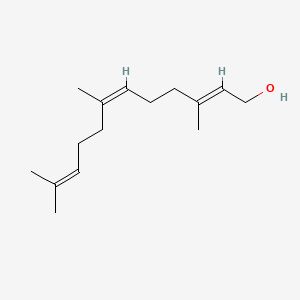| MeSH term | MeSH ID | Detail |
|---|---|---|
| Insulin Resistance | D007333 | 99 associated lipids |
| Candidiasis, Oral | D002180 | 11 associated lipids |
| Nerve Sheath Neoplasms | D018317 | 4 associated lipids |
(e,z)-farnesol
(e,z)-farnesol is a lipid of Prenol Lipids (PR) class.
Cross Reference
There are no associated biomedical information in the current reference collection.
Current reference collection contains 3613 references associated with (e,z)-farnesol in LipidPedia. Due to lack of full text of references or no associated biomedical terms are recognized in our current text-mining method, we cannot extract any biomedical terms related to diseases, pathways, locations, functions, genes, lipids, and animal models from the associated reference collection.
Users can download the reference list at the bottom of this page and read the reference manually to find out biomedical information.
Here are additional resources we collected from PubChem and MeSH for (e,z)-farnesol
Possible diseases from mapped MeSH terms on references
We collected disease MeSH terms mapped to the references associated with (e,z)-farnesol
PubChem Biomolecular Interactions and Pathways
All references with (e,z)-farnesol
Download all related citations| Authors | Title | Published | Journal | PubMed Link |
|---|---|---|---|---|
| Shapira S et al. | The tumor suppressor neurofibromin confers sensitivity to apoptosis by Ras-dependent and Ras-independent pathways. | 2007 | Cell Death Differ. | pmid:17096025 |
| Cetin A et al. | Angiotensin II-induced MAPK phosphorylation mediated by Ras and/or phospholipase C-dependent phosphorylations but not by protein kinase C phosphorylation in cultured rat vascular smooth muscle cells. | 2007 | Pharmacology | pmid:17135774 |
| Wiseman DA et al. | Cell cycle arrest by the isoprenoids perillyl alcohol, geraniol, and farnesol is mediated by p21(Cip1) and p27(Kip1) in human pancreatic adenocarcinoma cells. | 2007 | J. Pharmacol. Exp. Ther. | pmid:17138864 |
| Wendland J et al. | Use of the Porcine Intestinal Epithelium (PIE)-Assay to analyze early stages of colonization by the human fungal pathogen Candida albicans. | 2006 | J. Basic Microbiol. | pmid:17139615 |
| Fairn GD et al. | A chemogenomic screen in Saccharomyces cerevisiae uncovers a primary role for the mitochondria in farnesol toxicity and its regulation by the Pkc1 pathway. | 2007 | J. Biol. Chem. | pmid:17164236 |
| Nokhodchi A et al. | The effect of terpene concentrations on the skin penetration of diclofenac sodium. | 2007 | Int J Pharm | pmid:17174049 |
| Lombardi L et al. | Circadian rhythms in Neurospora crassa: clock mutant effects in the absence of a frq-based oscillator. | 2007 | Genetics | pmid:17237512 |
| Kuroda M et al. | Sesquiterpene farnesol inhibits recycling of the C55 lipid carrier of the murein monomer precursor contributing to increased susceptibility to beta-lactams in methicillin-resistant Staphylococcus aureus. | 2007 | J. Antimicrob. Chemother. | pmid:17242033 |
| Henriques M et al. | Effect of farnesol on Candida dubliniensis morphogenesis. | 2007 | Lett. Appl. Microbiol. | pmid:17257261 |
| Dumitru R et al. | In vivo and in vitro anaerobic mating in Candida albicans. | 2007 | Eukaryotic Cell | pmid:17259544 |
| Shintre MS et al. | Evaluation of an alcohol-based surgical hand disinfectant containing a synergistic combination of farnesol and benzethonium chloride for immediate and persistent activity against resident hand flora of volunteers and with a novel in vitro pig skin model. | 2007 | Infect Control Hosp Epidemiol | pmid:17265401 |
| Navarathna DH et al. | Effect of farnesol on a mouse model of systemic candidiasis, determined by use of a DPP3 knockout mutant of Candida albicans. | 2007 | Infect. Immun. | pmid:17283095 |
| Journe F et al. | Farnesol, a mevalonate pathway intermediate, stimulates MCF-7 breast cancer cell growth through farnesoid-X-receptor-mediated estrogen receptor activation. | 2008 | Breast Cancer Res. Treat. | pmid:17333335 |
| Touhara K and Prestwich GD | Binding site mapping of a photoaffinity-labeled juvenile hormone binding protein. | 1992 | Biochem. Biophys. Res. Commun. | pmid:1734862 |
| Blum R et al. | Gene expression signature of human cancer cell lines treated with the ras inhibitor salirasib (S-farnesylthiosalicylic acid). | 2007 | Cancer Res. | pmid:17409441 |
| Crowell DN et al. | Arabidopsis thaliana plants possess a specific farnesylcysteine lyase that is involved in detoxification and recycling of farnesylcysteine. | 2007 | Plant J. | pmid:17425716 |
| Woodard B et al. | 3D-QSAR of fungal quorum-sensing inhibiting analogs of farnesol. | 2007 Mar-Apr | J Environ Sci Health B | pmid:17454380 |
| Navarathna DH et al. | Exogenous farnesol interferes with the normal progression of cytokine expression during candidiasis in a mouse model. | 2007 | Infect. Immun. | pmid:17517874 |
| Cheng AX et al. | The rice (E)-beta-caryophyllene synthase (OsTPS3) accounts for the major inducible volatile sesquiterpenes. | 2007 | Phytochemistry | pmid:17524436 |
| Zundelevich A et al. | Suppression of lung cancer tumor growth in a nude mouse model by the Ras inhibitor salirasib (farnesylthiosalicylic acid). | 2007 | Mol. Cancer Ther. | pmid:17541036 |
